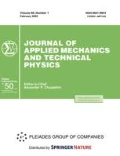Abstract
The electrical conductivity of silicate rocks (quartzite, granite, and dry and wet tuffs) under single shock–wave loading is measured. It is shown that even at a shock–wave pressure of 20 GPa, the conductivity of rocks changes by several orders of magnitude compared to the initial value (10−9 — 10−12 Ω−1 · m−1 for dry rocks) and reaches 0.01 Ω−1 · m−1 for quartzite and granite and 0.1 — 1.0 Ω−1 · m−1 for tuff. As the shock–wave amplitude increases from 20 to 60 GPa, the electrical conductivity increases by further one or two orders of magnitude. The experiments with rocks did not reveal a drastic change in electrical conductivity similar to the that observed for silicon dioxide (fused quartz) at a pressure of about 40 GPa.
Similar content being viewed by others
REFERENCES
M. A. Sadovskii, “Topical problems of geophysics in the complex of Earth sciences” Vestn. Akad. Nauk SSSR, No. 1, 60-63 (1968).
É. I. Parkhomenko and A. T. Bondarenko, Electrical Conductivity of Rocks at High Pressures and Temperatures [in Russian], Nauka, Moscow (1972).
K. I. Kondo, A. Sawaoka, and T. J. Ahrens, “Electrical measurements on fused quartz under shock compression” J. Appl. Phys., 52, No. 8, 5084-5089 (1981).
Q. Williams, E. Knittle, R. Reichlin, et al., “Structural and electronic properties of Fe 2SiO4-fayalite at ultrahigh pressures: Amorphization and gap closure” J. Geophys. Res., 95, No. B13, 21.549-21.563 (1990).
T. Mashimo, K. I. Kondo, A. Sawaoka, et al., “Electrical conductivity measurement of fayalite under shock compression up to 56 GPa” J. Geophys. Res., 85, 1876-1881 (1980).
A. A. Brish, M. S. Tarasov, and V. A. Tsukerman, “Electrical conductivity of explosion products of condensed explosives” Zh. Éksp. Teor. Fiz., 37, No. 6, 1543-1550 (1959).
K. Kani, T. Yamada, and M. Abe, “Hugoniot and electric resistivity measurement on amorphous Se” in: Proc. of the 4th Amer. Phys. Soc. Conf. on Shock Waves in Condensed Matter (Spokane, Washington, July 22-25, 1985), Plenum Press, New York (1986), pp. 477-482.
A. C. Mitchell and R. N. Keeler, “Technique for accurate measurement of the electrical conductivity of shocked fluids” Rev. Sci. Instrum., 39, No. 4, 513-522 (1968).
Yu. N. Zhugin, K. K. Krupnikov, N. A. Ovechkin, et al., “Some features of the dynamic compressibility of quartz” Fiz. Zemli, No. 10, 16-21 (1994).
J. Wackerle, “Shock-wave compression of quartz” J. Appl. Phys., 33, No. 2, 922-937 (1962).
S. P. Marsh (ed.), LASL Shock Hugoniot Data, Univ. California Press, Berkely, CA (1980).
A. N. Dremin and I. A. Karpukhin, “Method for determining the shock adiabats of dispersed materials” Prikl. Mekh. Tekh. Fiz., No. 3, 184-189 (1960).
I. I. Sharipdhzanov, L. V. Al'tshuler, and S. E. Brusnikin, “Anomalies of the shock and isentropic compressibility of water” Fiz. Goreniya Vzryva, 19, No. 5, 149-153 (1983).
T. J. Ahrens and J. T. Rosenberg, “Shock metamorphism: Experiments on quartz and plagioclase” in: Shock Metamorphism of Natural Materials, Mono Book Co., Baltimore (1968), pp. 59-81.
V. I. Postnov, S. S. Nabatov, and V. V. Yuakishev, “Investigation of the behavior of fused quartz behind the shock-wave front by measuring electrical conductivity” in: High-Energy Action on Materials, Proc. IX Int. Conf. (Novosibirsk, August 18-22, 1986), Institute of Hydrodynamics, Novosibirsk (1986), pp. 106-110.
G. A. Lyzenga and T. J. Ahrens, “Shock temperatures of SiO2 and their geophysical implications” J. Geophys. Res., 88, No. B3, 2431-2444 (1983).
L. V. Al'tshuler and I. I. Sharipdzhanov, “Additive equations of state for silicates at high pressures” Izv. Akad. Nauk SSSR, Fiz. Zemli, No. 3, 11-28 (1971).
Ya. B. Zel'dovich amd Yu. P. Raizer, Physics of Shock Waves and High-Temperature Magnetohydrodynamic Phenomena [in Russian], Nauka, Moscow (1966).
S. D. Hamann and M. Linton, “Electrical conductivity of water in shock compression” Trans. Farad. Soc., 62, 2234-2241 (1966).
Author information
Authors and Affiliations
Rights and permissions
About this article
Cite this article
Gorshkov, M.M., Zaikin, V.T. & Lobachev, S.V. Electrical Conductivity of Rocks under Shock Compression. Journal of Applied Mechanics and Technical Physics 42, 196–201 (2001). https://doi.org/10.1023/A:1018807415208
Issue Date:
DOI: https://doi.org/10.1023/A:1018807415208




